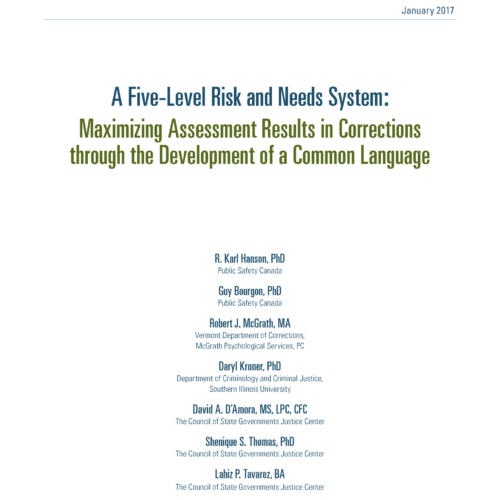
What are Risk and Needs Assessments?
Risk and needs assessments use an actuarial evaluation to guide decision making at various points across the criminal justice continuum by approximating a person’s likelihood of reoffending and determining what individual criminogenic needs must be addressed to reduce that likelihood. General criminogenic risk and needs assessment tools consist of questions that are designed to ascertain someone’s history of criminal behavior, attitudes and personality, and life circumstances.
These assessments are similar to actuarial tools used by insurance companies to rate risk: they predict the likelihood of future outcomes according to their analysis of “static” or past activities (e.g., age or criminal history) and “dynamic” or present conditions (e.g., antisocial attitudes or behavioral health needs). The results of these assessments help put people in groups of different risk levels, usually categorized as being at low, medium, or high risk of reoffending. (See Figure 1)
These assessments also help inform case planning and management to ensure that individual needs are met. Specialized assessments that address specific outcomes (e.g., sexual offending, violence) may be used in conjunction with general assessments. Pretrial risk and needs assessments are often shorter than general criminogenic risk assessments and assess for risk of rearrest and failure to appear in court.
When Should Risk and Needs Assessments be Used?
Risk and needs assessments can be administered at any time during a person’s contact with the criminal justice system—during the pretrial period, while on probation, after admission to a correctional facility, prior to release, and during post-release supervision. Objective risk and needs assessments have been shown to be more reliable than a professional’s individual judgment. These assessments should be used at multiple decision points to direct the supervision intensity, case planning and management, programming requirements, and treatment referrals.1 While risk and needs assessment should not be the sole factor in making these decisions, it is currently the best available method for ensuring that research-based data helps inform the decision-making process.

How Can Accuracy of Results be Ensured?
Risk and needs assessment tools must be routinely validated to ensure their accuracy. Validation studies should examine the instrument’s ability to identify groups of people with different probabilities of reoffending, including assuring accuracy across racial groups and by gender. Assessments should be checked for inter-rater reliability (i.e., that two different staff members score the same individual the same way on the risk instrument) and intra-rater reliability (i.e., an individual staff member scores the same person the same way repeatedly.) High-quality assessments require well-trained staff to conduct the assessments, clear and periodically updated scoring guidelines, regular validation studies, and ongoing quality improvement exercises.
- Christopher Lowenkamp and Edward Latessa, “Understanding the Risk Principle: How and Why Correctional Interventions Can Harm Low-Risk Offenders,” Topics in Community Corrections (2004) 3–8; Edward Latessa, “The Challenge of Change: Correctional Programs Analysis and Policy Framework and Evidence-Based Practices,” Criminology & Public Policy, 3, no. 4 (2004), 547–560.
Additional Resources
- CSG Justice Center, Three Things You Can Do to Prevent Bias in Risk Assessment, (New York: CSG Justice Center, 2015), https://csgjusticecenter.org/jr/posts/three-things-you-can-do-to-prevent-bias-in-risk-assessment/.
- CSG Justice Center developed a multi-point inspection protocol for assessing and improving the quality of your risk and needs assessment implementation (called the Risk Assessment Quality Improvement checklist).
- CSG Justice Center, Risk Assessment: What You Need to Know, (New York: CSG Justice Center, 2015), https://csgjusticecenter.org/reentry/posts/risk-assessment-what-you-need-to-know/.
- CSG Justice Center, How Justice Reinvestment States are Improving the Quality of Risk Assessment, (New York: CSG Justice Center, 2015), https://csgjusticecenter.org/jr/north-carolina/posts/how-justice-reinvestment-states-are-improving-the-quality-of-risk-assessment/..
- CSG Justice Center, Three Core Elements of Programs that Reduce Recidivism: Who, What, How Well, (New York: CSG Justice Center, 2015), https://csgjusticecenter.org/jr/posts/three-core-elements-of-programs-that-reduce-recidivism-who-what-and-how-well/.
- “Executive Summary of Risk Assessment Instruments Validated and Implemented in Correctional Settings in the United States,” (New York: CSG Justice Center, 2013), https://csgjusticecenter.org/wp-content/uploads/2014/07/Risk-Instruments-Guide.pdf.
- The Pew Charitable Trusts, Risk/Needs Assessment 101: Science Reveals New Tools to Manage Offenders, (Washington, D.C.: The Pew Charitable Trusts, September 2011), http://www.pewtrusts.org/en/research-and-analysis/issue-briefs/2011/09/20/riskneeds-assessment-101-science-reveals-new-tools-to-manage-offenders.
- Marshall Clement, Matthew Schwarzfeld, and Michael Thompson, “The National Summit on Justice Reinvestment and Public Safety: Addressing Recidivism, Crime, and Corrections Spending,” (New York: CSG Justice Center, 2011), https://csgjusticecenter.org/wp-content/uploads/2012/08/JR_Summit_Report_Final.pdf.
Disclaimer: This project was supported by Grant No. 2015-ZB-BX-K001 awarded by the Bureau of Justice Assistance. The Bureau of Justice Assistance is a component of the Department of Justice’s Office of Justice Programs, which also includes the Bureau of Justice Statistics, the National Institute of Justice, the Office of Juvenile Justice and Delinquency Prevention, the Office for Victims of Crime, and the SMART Office. Points of view or opinions in this document are those of the author and do not necessarily represent the official position or policies of the U.S. Department of Justice.
Arkansas policymakers have long expressed concerns about the state’s high recidivism rate. Over the past 10 years, an…
Read More Explainer: Key Findings and Options from Arkansas’s Justice Reinvestment Initiative
Explainer: Key Findings and Options from Arkansas’s Justice Reinvestment Initiative
Arkansas policymakers have long expressed concerns about the state’s high recidivism rate. Over the past 10 years, an estimated 72 percent of prison admissions in the state involved people who were revoked from supervision, with unmet substance use and mental health challenges playing a significant role in these failures.
Read More














